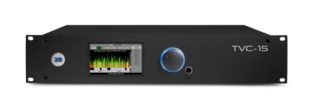If you’re a David Bowie fan, you’re going to love the name of the newest broadcast watermark analyzer and monitor on the market, courtesy of The Telos Alliance.
The company leading the charge into an ATSC 3.0 world has just launched the 25-Seven TVC-15, being marketed as “a modulation monitor for watermarking.”
The device is designed to allow stations in electronically measured markets to independently detect, monitor, and analyze how well each element in their programming supports audio watermarking.
Measurements happen in real time, right off the air, without being connected to a watermark encoder. Every 400 milliseconds, TVC-15’s tone verification codec detects and analyzes the actual code symbols in any audio fed to it.
“Standard analog inputs mean you can monitor any source, live or recorded,” Telos notes. “A front-panel graph of your station’s watermark density gives you a granular, moment-by-moment display; you can also download reports to look at encoding quality over hours, days and weeks. With TVC-15, stations now have a tool to independently verify the presence and relative quality of watermark tones embedded in their programming.”
Geoff Steadman, founder of 25-Seven Systems, commented, “Broadcasting is a numbers business. Broadcasters’ success depends on what kind of audience they attract and hold, and we all know there’s a direct link between ratings and a station’s revenue in electronically measured markets. Having comprehensive tools—ones that help you understand the entire watermarking ecosystem—is essential to your station’s competitive picture. When we introduced Voltair two years ago, users asked if we could detect watermarks right off air, or at any patch point. With TVC-15, now we can provide a complete, end-to-end picture of your and your competitors’ encoding.”
As an option for stations with a Voltair watermark monitor and processor, TVC-15 can also be utilized to automatically adjust enhancement levels in real-time. TVC-15’s Adaptive Enhancement (AE) closes the feedback loop, letting broadcasters dynamically control Voltair processing based on moment-by-moment analysis of their actual air signal, pushing enhancement when it is needed, while backing off when not.
“This application allows Voltair users to better optimize the trade off between robust watermarking and clean audio,” Steadman said.





